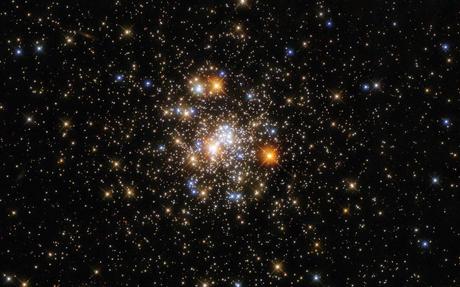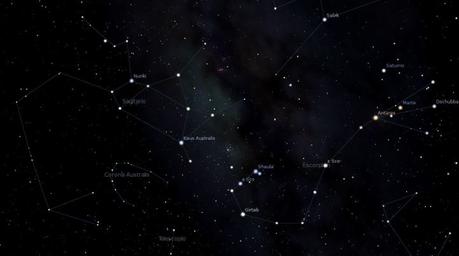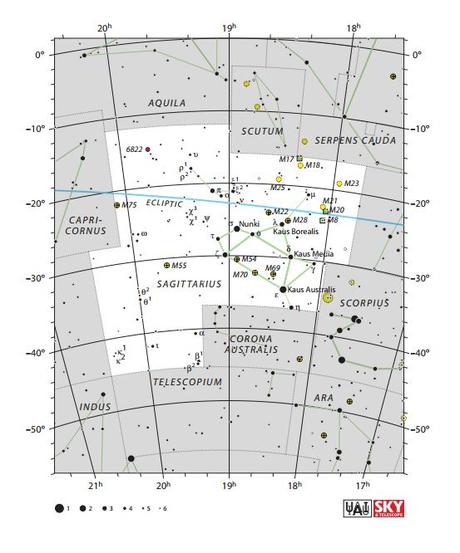En la imagen que podéis apreciar podemos ver al cúmulo globular NGC 6717, este se encuentra a más de 20.000 años luz de la Tierra en la constelación de Sagitario. Los cúmulos globulares contienen más estrellas en sus centros que en sus franjas exteriores, como lo demuestra acertadamente esta imagen, los bordes escasamente poblados de NGC 6717 están en marcado contraste con la brillante colección de estrellas en su centro.

This star-studded image from the NASA/ESA Hubble Space Telescope depicts NGC 6717, which lies more than 20 000 light-years from Earth in the constellation Sagittarius. NGC 6717 is a globular cluster, a roughly spherical collection of stars tightly bound together by gravity. Globular clusters contain more stars in their centres than their outer fringes, as this image aptly demonstrates; the sparsely populated edges of NGC 6717 are in stark contrast to the sparkling collection of stars at its centre. The centre of the image also contains some interlopers from closer to home. Bright foreground stars close to Earth are surrounded by criss-cross diffraction spikes formed by starlight interacting with the structures supporting Hubble’s secondary mirror. The area of the night sky which contains the constellation Sagittarius also contains the centre of the Milky Way, which is filled with light-absorbing gas and dust. This absorption of light — which astronomers refer to as extinction — makes studying globular clusters near the Galactic centre a challenging endeavour. To determine the properties of NGC 6717, astronomers relied on a combination of Hubble’s Wide Field Camera 3 and the Advanced Camera for Surveys. Links Video of A Glittering Globular Cluster
" data-orig-size="1041,651" sizes="(max-width: 1024px) 100vw, 1024px" data-image-title="A Glittering Globular Cluster" data-orig-file="https://josevicentediaz.files.wordpress.com/2021/09/cumulo-brillante-sagitario.jpg" data-image-description="" data-image-meta="{"aperture":"0","credit":"ESA\/Hubble and NASA, A. Sarajedi","camera":"","caption":"This star-studded image from the NASA\/ESA Hubble Space Telescope depicts NGC 6717, which lies more than 20 000 light-years from Earth in the constellation Sagittarius. NGC 6717 is a globular cluster, a roughly spherical collection of stars tightly bound together by gravity. Globular clusters contain more stars in their centres than their outer fringes, as this image aptly demonstrates; the sparsely populated edges of NGC 6717 are in stark contrast to the sparkling collection of stars at its centre. The centre of the image also contains some interlopers from closer to home. Bright foreground stars close to Earth are surrounded by criss-cross diffraction spikes formed by starlight interacting with the structures supporting Hubble\u2019s secondary mirror. The area of the night sky which contains the constellation Sagittarius also contains the centre of the Milky Way, which is filled with light-absorbing gas and dust. This absorption of light \u2014 which astronomers refer to as extinction \u2014 makes studying globular clusters near the Galactic centre a challenging endeavour. To determine the properties of NGC 6717, astronomers relied on a combination of Hubble\u2019s Wide Field Camera 3 and the Advanced Camera for Surveys. Links Video of\u00a0A Glittering Globular Cluster","created_timestamp":"1630908000","copyright":"","focal_length":"0","iso":"0","shutter_speed":"0","title":"A Glittering Globular Cluster","orientation":"0"}" data-medium-file="https://josevicentediaz.files.wordpress.com/2021/09/cumulo-brillante-sagitario.jpg?w=300" data-permalink="https://josevicentediaz.com/a-glittering-globular-cluster/" alt="" srcset="https://josevicentediaz.files.wordpress.com/2021/09/cumulo-brillante-sagitario.jpg?w=1024 1024w, https://josevicentediaz.files.wordpress.com/2021/09/cumulo-brillante-sagitario.jpg?w=150 150w, https://josevicentediaz.files.wordpress.com/2021/09/cumulo-brillante-sagitario.jpg?w=300 300w, https://josevicentediaz.files.wordpress.com/2021/09/cumulo-brillante-sagitario.jpg?w=768 768w, https://josevicentediaz.files.wordpress.com/2021/09/cumulo-brillante-sagitario.jpg 1041w" class="wp-image-27173" data-large-file="https://josevicentediaz.files.wordpress.com/2021/09/cumulo-brillante-sagitario.jpg?w=723" />Créditos: ESA / Hubble y NASA, A. SarajediniLa constelación de Sagitario se encuentra en la misma área del cielo nocturno que el centro de la Vía Láctea, que está llena de gas y polvo que absorben la luz. Esta absorción de luz, que los astrónomos llaman “extinción“, hace que el estudio de los cúmulos globulares cerca del centro galáctico sea un desafío.
Sagitario, laboratorio de estrellas
Sagitario es una constelación muy antigua que representa a un centauro, mitad hombre mitad animal, alzando un arco y una flecha. Se la representa apuntando al corazón del escorpión (la estrella Antares de la constelación del escorpión).

A menudo se identifican las estrellas como dibujando la forma de una tetera como podemos ver en la imagen superior, una forma muy característica para poder identificarla, aunque también se dibuja un cucharón, llamado cucharón de leche.
Es una constelación maravillosa, en ella hay decenas de objetos celestes impresionantes, es una de las zonas más ricas para observación astronómica del firmamento. Además el centro de la Vía Láctea se sitúa en sagitario, de modo que los campos de estrellas son muy ricos en esta zona del cielo. El centro de la galaxia lo marca una fuente de radio llamada Sagitario A, que es un agujero negro muy masivo, este se encuentra entre Sagitario y la constelación de Escorpio.

El atractivo de Sagitario es enorme, tiene decenas de racimos de estrellas y nebulosas, y un fondo de estrellas maravilloso como hemos visto en la primera imagen.
Anuncios
